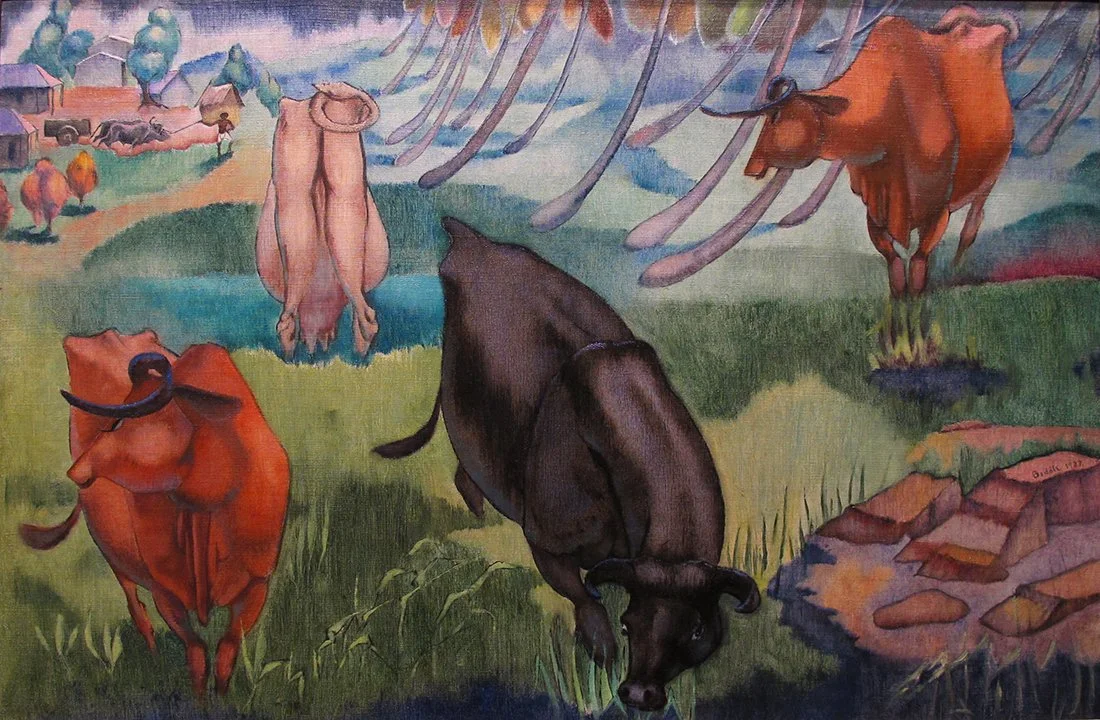GEORGE BIDDLE (1885-1973)
Available Work | Biography
Biography • George Biddle (1885-1973)
George Biddle was born in 1885 to a prominent Philadelphia family. Although he received a law degree from Harvard University and was admitted to the Pennsylvania Bar in 1911, Biddle pursued a career in art. In 1911 Biddle went to Paris to study at the Académie Julian, returning to Philadelphia in 1912 to enroll at the Pennsylvania Academy of the Fine Arts. Biddle returned to Europe in 1914 to study printmaking in Munich before going to Paris. The summers of 1915 and 1916 were spent with the American expatriate artist Frederick Carl Frieseke in Giverny. Edgar Degas and especially Mary Cassatt were friends of Biddle's family and kept an eye on his artistic development while he was in France.
In 1917 Biddle returned to Philadelphia to pursue his career as an artist, but marriage and then service in the army interrupted his work. In 1919, when Biddle's marriage failed, he traveled to Tahiti for isolation and inspiration. In Tahiti he experimented with linocuts, woodcuts and lithotints, as well as painting colorful images of the island and its natives. A one-man exhibition of Biddle's Tahitian paintings was held at the Milch Gallery in 1920. In 1922 Biddle returned to the United States and worked in New York with a group of talented, younger artists, some of whom- Marguerite and William Zorach, Elie Nadelman and Gaston Lachaise- became lasting friends. He continued to work in various media and had several successful exhibitions in New York galleries, including Wildenstein and Weyhe Galleries.
Biddle returned to Paris for two years in 1924 to sculpt stone, clay, and wood and worked seriously as a printmaker again. In Paris he met Jules Pascin, who became a close friend and is credited with helping Biddle achieve greater plasticity. In 1925 Biddle re-married and traveled to Cuba and Haiti in 1926-1927.
In 1928 Biddle accompanied Diego Rivera on a sketching trip through Mexico. Impressed by the passion and the political and social awareness of the Mexican muralists, Biddle decided to devote his own art to the contemporary American scene and to paint the social, economic, and political issues facing America. A one-man exhibition of Biddle's Mexican works was held at the Frank Rehn Gallery, his dealer until 1939, in New York in 1929. In 1933 Biddle proposed his idea of a government-sponsored mural program similar to the one he witnessed in Mexico to President Franklin Delano Roosevelt. After many meetings with Roosevelt and other government officials, the Federal Arts Program was implemented.
In 1930 George and Ira Gershwin commissioned George Biddle to illustrate the libretto for Porgy and Bess. The artist spent May and June in Charleston, where he produced a large folio of drawings of the local people involved in everyday activities from which the illustrations for the libretto of Porgy and Bess were selected. Paintings created from the Charleston sketches were exhibited at the Downtown Gallery, New York. Biddle's second marriage to Jane Belo ended in 1929 and in 1931 he married the Belgian sculptress Hélène Sardeau. The couple spent a year in Rome working on oils, drawings, lithographs, and ceramics. They returned in 1932 to the home Biddle had built in Croton-on-Hudson.
George Biddle executed his first mural in 1933 for the Chicago World's Fair. In 1936 he executed a mural for the Department of Justice, Washington, D.C. In 1940 Biddle collaborated with his wife to execute the frescoes and sculptures for the Supreme Court Building in Mexico City. In 1942 Biddle received the mural commission and Sardeau received the sculpture commission for the Biblioteca Nacional, Rio de Janeiro. Biddle had his first teaching position at the Colorado Springs Fine Art Center from December 1936 to June 1937. In 1941 Biddle was the artist-in-residence at the Otis Art Institute in California. It was in Colorado Springs that Biddle executed Death on the Plains both in oil and in print form as a commentary on the drastic effects of the Dust Bowl droughts on the mid-Western farm states.
Biddle's work was included in exhibitions at the Whitney Museum of American Art, the National Academy of Design, the Society of Independent Artists, the Art Institute of Chicago, the Colorado Springs Arts Center, the 1939 New York World's Fair, the Pennsylvania Academy of the Fine Arts, and the Associated American Artists Gallery from 1940 to 1949. Biddle became a member of artist organizations at this time such as the American Artists Group, Inc.; the Muralist Guild; the Society of Painters, Gravers, and Sculptors; and participated in the first American Artists Congress in 1936.
In 1943 Biddle was appointed Chairman of the U.S. War Artists Committee and spent six months with American troops in Tunisia, North Africa recording his observations in drawings and watercolors. Many of these works were published in George Biddle's War Drawings in 1944. In 1950 George Biddle was appointed to a four-year term on the Fine Arts Commission by President Truman. Biddle spent the following year, from 1951 to 1952, as the artist-in-residence at the American Academy in Rome. He was awarded the Huntington Hartford Foundation Prize in 1954, which led him to be an artist-in-residence in 1955 at the Foundation's home in one of the canyons of Los Angeles, California. He spent most of the following years in Croton and travel in later years took him to Japan, Southeast Asia, India and Italy. George Biddle died in Croton on November 6, 1973.
